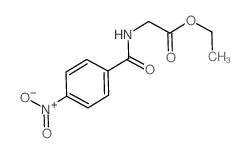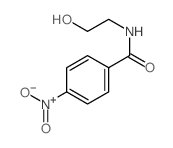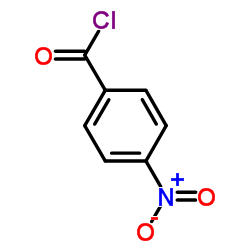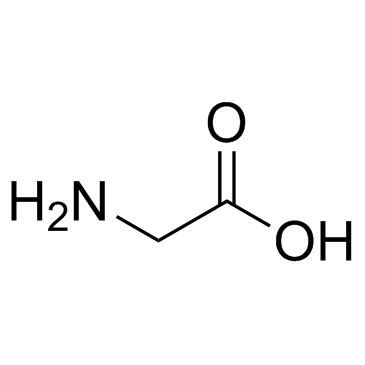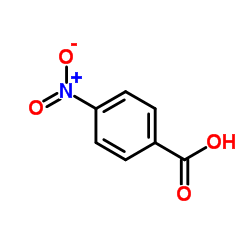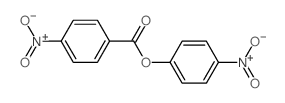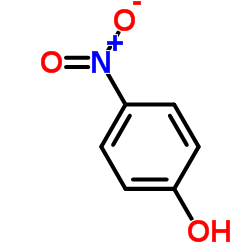4-nitrohippuric acid
Modify Date: 2024-01-28 18:53:14
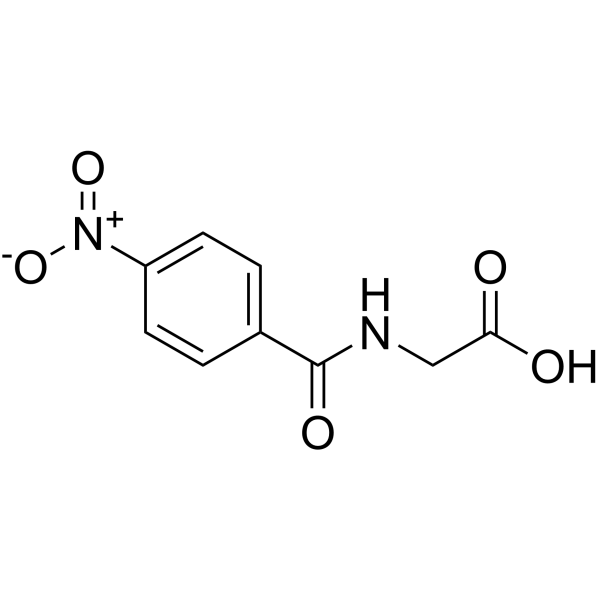
4-nitrohippuric acid structure
|
Common Name | 4-nitrohippuric acid | ||
|---|---|---|---|---|
| CAS Number | 2645-07-0 | Molecular Weight | 224.17000 | |
| Density | 1.467g/cm3 | Boiling Point | 531.2ºC at 760mmHg | |
| Molecular Formula | C9H8N2O5 | Melting Point | 131-133 °C(lit.) | |
| MSDS | N/A | Flash Point | 275ºC | |
Use of 4-nitrohippuric acidN-(4-Nitrobenzoyl)glycine is a Glycine (HY-Y0966) derivative[1]. |
| Name | 2-[(4-nitrobenzoyl)amino]acetic acid |
|---|---|
| Synonym | More Synonyms |
| Description | N-(4-Nitrobenzoyl)glycine is a Glycine (HY-Y0966) derivative[1]. |
|---|---|
| Related Catalog | |
| In Vitro | Amino acids and amino acid derivatives have been commercially used as ergogenic supplements. They influence the secretion of anabolic hormones, supply of fuel during exercise, mental performance during stress related tasks and prevent exercise induced muscle damage. They are recognized to be beneficial as ergogenic dietary substances[1]. |
| References |
| Density | 1.467g/cm3 |
|---|---|
| Boiling Point | 531.2ºC at 760mmHg |
| Melting Point | 131-133 °C(lit.) |
| Molecular Formula | C9H8N2O5 |
| Molecular Weight | 224.17000 |
| Flash Point | 275ºC |
| Exact Mass | 224.04300 |
| PSA | 112.22000 |
| LogP | 1.32330 |
| Vapour Pressure | 4.11E-12mmHg at 25°C |
| Storage condition | 2-8°C |
Synonym:N-(4-Nitrobenzoyl)glycin Section 2 - COMPOSITION, INFORMATION ON INGREDIENTS
Risk Phrases: None Listed. Section 3 - HAZARDS IDENTIFICATION EMERGENCY OVERVIEW
The toxicological properties of this material have not been fully investigated. Potential Health Effects Eye: May cause eye irritation. Skin: May cause skin irritation. Ingestion: May cause irritation of the digestive tract. The toxicological properties of this substance have not been fully investigated. Inhalation: May cause respiratory tract irritation. The toxicological properties of this substance have not been fully investigated. Chronic: No information found. Section 4 - FIRST AID MEASURES Eyes: Flush eyes with plenty of water for at least 15 minutes, occasionally lifting the upper and lower eyelids. Get medical aid immediately. Skin: Get medical aid. Flush skin with plenty of water for at least 15 minutes while removing contaminated clothing and shoes. Ingestion: If victim is conscious and alert, give 2-4 cupfuls of milk or water. Get medical aid immediately. Inhalation: Get medical aid immediately. Remove from exposure and move to fresh air immediately. If not breathing, give artificial respiration. If breathing is difficult, give oxygen. Notes to Physician: Section 5 - FIRE FIGHTING MEASURES General Information: As in any fire, wear a self-contained breathing apparatus in pressure-demand, MSHA/NIOSH (approved or equivalent), and full protective gear. Extinguishing Media: Use water spray, dry chemical, carbon dioxide, or chemical foam. Section 6 - ACCIDENTAL RELEASE MEASURES General Information: Use proper personal protective equipment as indicated in Section 8. Spills/Leaks: Vacuum or sweep up material and place into a suitable disposal container. Clean up spills immediately, observing precautions in the Protective Equipment section. Avoid generating dusty conditions. Provide ventilation. Section 7 - HANDLING and STORAGE Handling: Wash thoroughly after handling. Use with adequate ventilation. Minimize dust generation and accumulation. Avoid contact with eyes, skin, and clothing. Keep container tightly closed. Avoid ingestion and inhalation. Storage: Store in a tightly closed container. Store in a cool, dry, well-ventilated area away from incompatible substances. Section 8 - EXPOSURE CONTROLS, PERSONAL PROTECTION Engineering Controls: Facilities storing or utilizing this material should be equipped with an eyewash facility and a safety shower. Use process enclosure, local exhaust ventilation, or other engineering controls to control airborne levels. Exposure Limits CAS# 2645-07-0: Personal Protective Equipment Eyes: Wear appropriate protective eyeglasses or chemical safety goggles as described by OSHA's eye and face protection regulations in 29 CFR 1910.133 or European Standard EN166. Skin: Wear appropriate protective gloves to prevent skin exposure. Clothing: Wear appropriate protective clothing to prevent skin exposure. Respirators: Follow the OSHA respirator regulations found in 29 CFR 1910.134 or European Standard EN 149. Use a NIOSH/MSHA or European Standard EN 149 approved respirator if exposure limits are exceeded or if irritation or other symptoms are experienced. Section 9 - PHYSICAL AND CHEMICAL PROPERTIES Physical State: Solid Color: yellow Odor: Not available. pH: Not available. Vapor Pressure: Not available. Viscosity: Not available. Boiling Point: Not available. Freezing/Melting Point: 131 - 133 deg C Autoignition Temperature: Not available. Flash Point: Not available. Explosion Limits, lower: Not available. Explosion Limits, upper: Not available. Decomposition Temperature: Solubility in water: Specific Gravity/Density: Molecular Formula: C9H8N2O5 Molecular Weight: 224.17 Section 10 - STABILITY AND REACTIVITY Chemical Stability: Stable under normal temperatures and pressures. Conditions to Avoid: Dust generation. Incompatibilities with Other Materials: Strong oxidizing agents, strong bases. Hazardous Decomposition Products: Carbon monoxide, oxides of nitrogen, carbon dioxide. Hazardous Polymerization: Has not been reported. Section 11 - TOXICOLOGICAL INFORMATION RTECS#: CAS# 2645-07-0: MC0785000 LD50/LC50: Not available. Carcinogenicity: 4-Nitrohippuric acid - Not listed by ACGIH, IARC, or NTP. Other: See actual entry in RTECS for complete information. Section 12 - ECOLOGICAL INFORMATION Other No information available. Section 13 - DISPOSAL CONSIDERATIONS Dispose of in a manner consistent with federal, state, and local regulations. Section 14 - TRANSPORT INFORMATION IATA Not regulated as a hazardous material. IMO Not regulated as a hazardous material. RID/ADR Not regulated as a hazardous material. Section 15 - REGULATORY INFORMATION European/International Regulations European Labeling in Accordance with EC Directives Hazard Symbols: Not available. Risk Phrases: Safety Phrases: S 24/25 Avoid contact with skin and eyes. WGK (Water Danger/Protection) CAS# 2645-07-0: No information available. Canada None of the chemicals in this product are listed on the DSL/NDSL list. CAS# 2645-07-0 is not listed on Canada's Ingredient Disclosure List. US FEDERAL TSCA CAS# 2645-07-0 is not listed on the TSCA inventory. It is for research and development use only. SECTION 16 - ADDITIONAL INFORMATION N/A |
CHEMICAL IDENTIFICATION
HEALTH HAZARD DATAACUTE TOXICITY DATAMUTATION DATA
|
| WGK Germany | 3 |
|---|---|
| RTECS | MC0785000 |
| HS Code | 2924299090 |
|
~64% 
4-nitrohippuric acid CAS#:2645-07-0 |
| Literature: F2G LTD Patent: WO2008/62182 A1, 2008 ; Location in patent: Page/Page column 153 ; |
|
~83% 
4-nitrohippuric acid CAS#:2645-07-0 |
| Literature: Barati, Behjat; Moghadam, Majid; Rahmati, Abbas; Tangestaninejad, Shahram; Mirkhani, Valiollah; Mohammadpoor-Baltork, Iraj Synlett, 2013 , vol. 24, # 1 p. 90 - 96 |
|
~86% 
4-nitrohippuric acid CAS#:2645-07-0 |
| Literature: Jursic; Neumann Synthetic Communications, 2001 , vol. 31, # 4 p. 555 - 564 |
|
~% 
4-nitrohippuric acid CAS#:2645-07-0 |
| Literature: DeRuiter, Jack; Swearingen, Blake E.; Wandrekar, Vinay; Mayfield, Charles A. Journal of Medicinal Chemistry, 1989 , vol. 32, # 5 p. 1033 - 1038 |
|
~% 
4-nitrohippuric acid CAS#:2645-07-0 |
| Literature: Curran, Terence C; Farrar, Charles R.; Niazy, Omima; Williams, Andrew Journal of the American Chemical Society, 1980 , vol. 102, # 22 p. 6828 - 6837 |
|
~% 
4-nitrohippuric acid CAS#:2645-07-0 |
| Literature: Lebedukho; Kuritsyn; Sadovnikov Russian Journal of General Chemistry, 2004 , vol. 74, # 2 p. 222 - 224 |
|
~% 
4-nitrohippuric acid CAS#:2645-07-0 |
| Literature: Um, Ik-Hwan; Chung, Eun-Kyung; Lee, So-Mi Canadian Journal of Chemistry, 1998 , vol. 76, # 6 p. 729 - 737 |
| HS Code | 2924299090 |
|---|---|
| Summary | 2924299090. other cyclic amides (including cyclic carbamates) and their derivatives; salts thereof. VAT:17.0%. Tax rebate rate:13.0%. . MFN tariff:6.5%. General tariff:30.0% |
| Hippuric acid,p-nitro |
| MFCD00007349 |
| 4-Nitrohippuric acid |
| EINECS 220-156-5 |
| p-nitrohippuric acid |
| 4-nitro-hippuric acid |
| p-Nitrobenzoylglycine |
